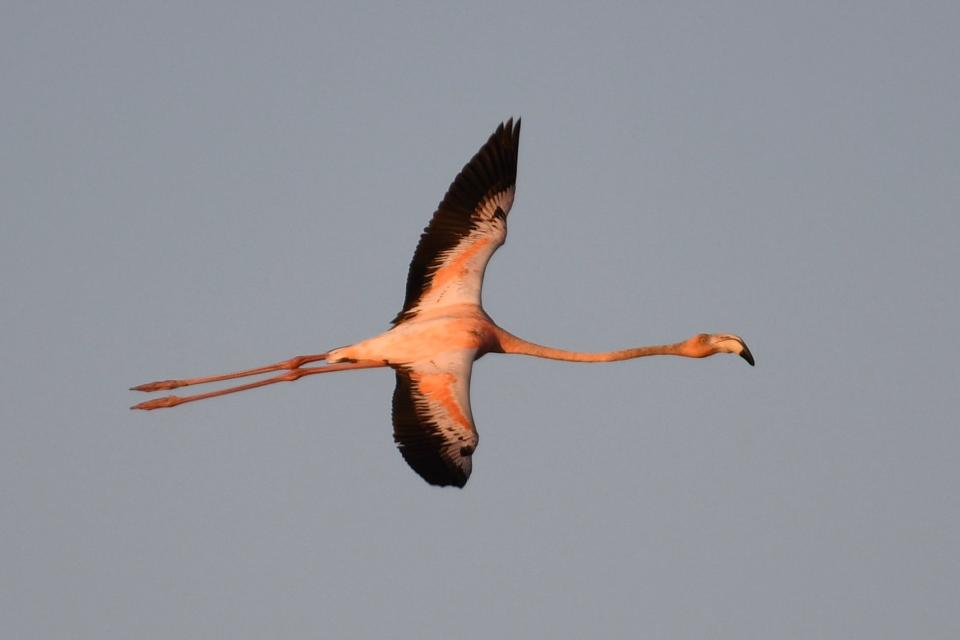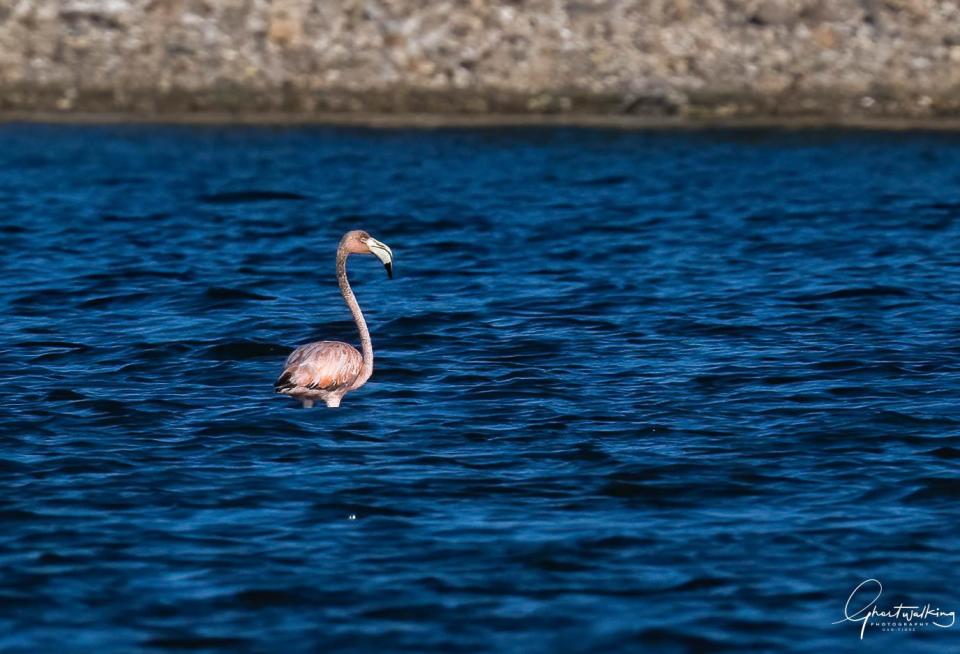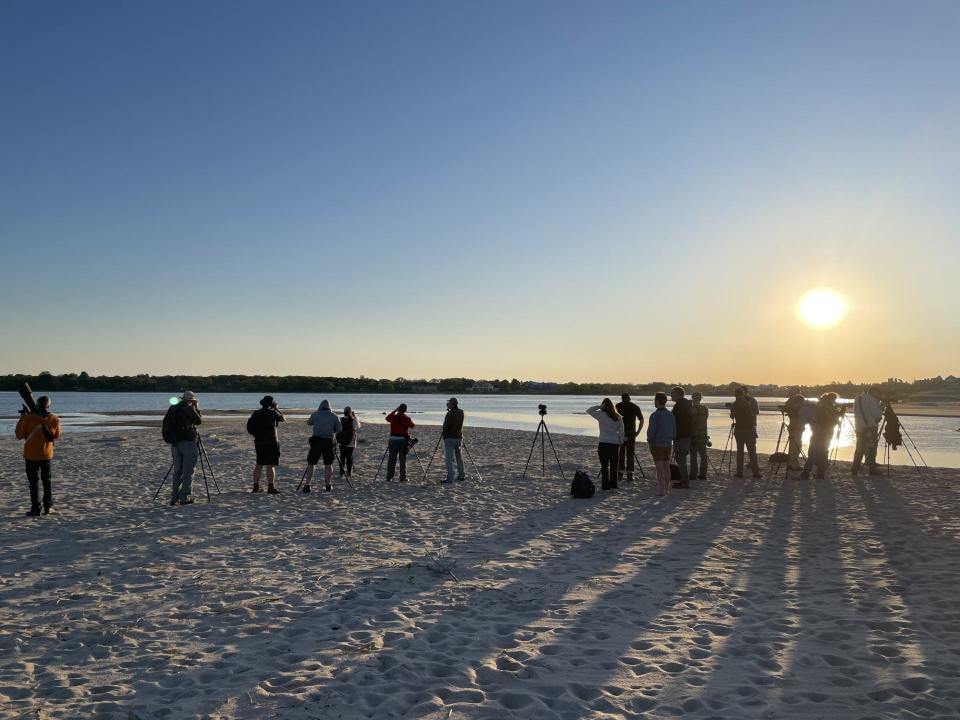In the pink: Flamingo sightings flying high in odd places as Hurricane Idalia's wrath lingers
It’s the height of the season in the Hamptons, but a flamingo sighting may be the summer’s main event.
The Hamptons are just one of more than a dozen locations seeing flamingos in recent weeks along the East and Gulf coasts, including on Cape Cod.
More than 100 flamingos arrived with the winds of Hurricane Idalia last August. They were seen in 18 states from Florida to Wisconsin and as far west as Kansas and Texas. Avian scientists weren't quite sure what would happen next.
Some birds returned to the Yucatan Peninsula, but many lingered in Florida over the winter. Now that summer is approaching, the birds appear to be surprising scientists by wandering around.
In New York, Tim Healy drove two hours from his home in Queens before dawn on June 1, after hearing about the rare sighting of a flamingo in East Hampton on Long Island. When he and a friend arrived, as they were discussing plans to find the bird, Healy turned toward the beach.
“This thing is flying in from the west dramatically, perfectly illuminated in the sunlight,” a cause for celebration among the couple of dozen birders gathered to see it, Healy said. “It was absolutely incredible.”

Idalia's surprising delivery
Experts say Idalia likely brought the pink, leggy birds over from the huge colonies in conservation areas on the Yucatan Peninsula, a theory at least partly confirmed by bands found on flamingos in Florida that were traced back to flamingo chicks in Yucatan.
Then over the winter, one of the banded birds seen in the Florida Keys after Idalia was spotted again in Yucatan, said Jerry Lorenz, Audubon Florida's state director of research, based at the Everglades Science Center.
The birds fly back and forth between Mexico, Cuba and South Florida. But although they fly over Florida, no nesting has been documented in that state in decades, even though sightings have increased since 1990. Lorenz and others hope that may change with this latest influx of birds.
In February, he coordinated an effort to count the flamingos in Florida. They found 101 wild flamingos.
In May, a flock as big as 10 birds was reported at Merritt Island National Wildlife Refuge on the east coast. A flock of 12 was seen at Ding Darling National Wildlife Refuge on Southwest Florida's Sanibel Island and a flock of 43 was reported in the Everglades, according to eBird.org, an online database for bird observations by the Cornell Lab of Ornithology and Audubon.
Now that temperatures are warming, Lorenz thinks some of the birds that overwintered in Florida are beginning to explore. In recent weeks, a flock of five flamingos was seen near St. Simons Island, Georgia. In addition to the bird on Long Island, and sightings in Cape Cod, sightings also have been reported elsewhere.
Among the recent sightings reported on eBird:
One bird in the Cape Romain National Wildlife Refuge, South Carolina.
A single bird in and around Port Aransas, Texas.
A single bird in Pascagoula Beach, Mississippi.
A group of three flamingos in Dauphin Island, Alabama, in April.
What about the flamingo sightings in New York and Cape Cod?
"It could just be one of those birds that's gone into wandering mode somehow," said Mark Faherty, science coordinator with Mass Audubon at the Wellfleet Bay Wildlife Sanctuary on Cape Cod.
The Massachusetts flamingo sighting was in Dennis on the afternoon of June 2. It hasn't been reported again. On June 5, a flurry of flamingo sightings were reported west of the Hamptons on Long Island.

If the sightings are confirmed as wild birds, it would be the first wild flamingos in New York and Massachusetts. "That Idalia event where all those flamingos were deposited all over lends credibility" to the sightings being a wild flamingo, Faherty said.
Healy is a member of New York’s state avian records committee, which he said will have the final say over whether the Long Island flamingo is officially considered the state’s first wild member of the species. One unconfirmed bird was reported along the Hudson River last year among the other sightings along the East Coast, but there was no photo and the sighting couldn’t be documented.

Healy now wonders if any of a few sightings last century that were considered escapes could really have been wild birds. It’s only now with technology and a proliferation of cameras and communication tools that can so easily document bird sightings, he said, that scientists are beginning to understand how flamingos have a capacity to wander long distances.
Was the same flamingo seen on Cape Cod and Long Island?
They can't say for sure, but Healy and Faherty suspect it may have been the same young bird.
"It's not that far between Long Island and Cape Cod, about 114 miles," Faherty said.
Each time, the bird photographed had similar pinkish, gray plumage, indicating the bird was not a juvenile, but not quite an adult either, said Healy, a high school biology teacher.
It’s not ironclad, but none of the birds were seen concurrently and all the sightings reported so far were within about 200 miles, Healy said.
For New York birders, who were disappointed their state missed out on the wandering flamingos immediately after Idalia, the sightings on Long Island were thrilling.
Healy's trip to Long Island Saturday was “well worth it,” he said. “I’ve seen no shortage of incredible and unexpected birds. Just to get to see a flamingo on Long Island, it was absolutely spectacular."
Dinah Voyles Pulver covers climate and the environment for USA TODAY. Reach her at dpulver@gannett.com or @dinahvp
This article originally appeared on USA TODAY: Flamboyant pink flamingos pop up on East Coast, Hamptons and Cape Cod


